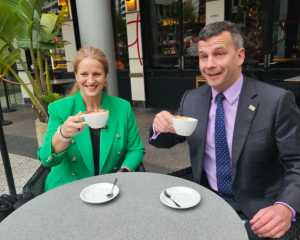
A rate cut from 2.25% to 2% in New Zealand next Thursday is fully priced in by the market.
Rates in Britain are now 0.25% and are 1.5% in Australia. Rates are near zero in both the United States and Japan and negative in Europe.
The Bank of England also unleashed billions of pounds of stimulus to cushion the economic shock from Britain’s vote to leave the European Union.
The British rate cut was the first since 2009.
Governor Mark Carney said by acting early and comprehensively, the bank could reduce uncertainty, bolster confidence, blunt the slow down and support the necessary adjustments in the UK economy.
The pound fell by 1.6% against the US dollar and the New Zealand and Australian currencies rose against the pound and the US dollar.
Mr Carney said he had unveiled an "exceptional package of measures" because the economic outlook had changed markedly following the Brexit vote.
The bank expected the economy to stagnate for the rest of the year and suffer weak growth. In New Zealand, economic growth remains strong but was not generating enough price pressures to lift inflation back to the Reserve Bank’s mid-point target of 2%.
Annual inflation was at 0.4%.
HSBC Australia-New Zealand chief economist Paul Bloxham said the Reserve Bank’s published forecasts, which would be updated next week, would also have to incorporate a markedly stronger dollar, which was likely to mean it would be even longer before inflation was projected to return to target.
As a result, the key question was not whether there was a rate cut next week but how much further might the Reserve Bank need to go, he said.
Some in the market were already asking whether the Reserve Bank could choose to cut by 0.5% next week.
"We doubt this is likely as it would give the sense of an emergency situation which we do not believe New Zealand faces. Growth is still holding up well, supported by construction and the tourism industries."
HSBC had joined other forecasters in predicting two cuts this year, taking the OCR to 1.75% by Christmas but did not believe the central bank would cut significantly from there, Mr Bloxham said.
Although inflation was too low, there were some signs domestic inflation had at least stabilised. Commodity prices were likely to be past the trough, which should lift local incomes.
China’s growth was also expected to remain solid, which should support demand for New Zealand’s services exports. The US Federal Reserve’s next move was likely to be up, pushing the New Zealand dollar lower over time.
Another factor which could limit the willingness of the Reserve Bank to cut a lot further was the booming housing market.
Further rate cuts would only exacerbate housing market risks, he said.
BNZ strategist Kimberley Martin said the core view remained for the Reserve Bank to cut next week and make a further cut by the end of the year.
If the Reserve Bank was true to its inflation forecasting model, risks were tilted towards even more cuts, she said.
"We would not be surprised if next week’s update to the Reserve Bank’s 90-day bank bill track implies OCR cuts to at least 1.5%."
The Bank of England left its forecast for economic growth at 2% as the economy expanded faster in the first half of 2016 than it had expected in May.
However, 2017 brought a sharp downgrade to growth of just 0.8% from a previous estimate of 2.3% — the biggest downgrade in growth from one Inflation Report to the next, exceeding what was seen in the financial crisis.
The growth outlook for 2018 was cut to 1.8%.
Mr Carney said at a press conference, he was not a fan of negative interest rates.
"We see the negative consequences through the financial system and see them in other jurisdictions. We have other options to provide stimulus if more stimulus is needed, so we don’t need to go to that as a last resort. We are very clear we see the effective lower bound for interest rates as a positive number."
Retail banks had no excuse not to pass on cuts in the bank rate and they should write to their customers to make the point, Mr Carney said.
He acknowledged the problems faced by savers in a low interest rate environment.
"This is something we think about a lot as a group of people who have worked hard, absolutely done the right thing, set money aside and the returns are very low and they’re likely to be low for some time. That’s true in the UK — it’s true in all advanced economies."
At a glance
• Bank of England cuts rates to 0.25% and unleashes billions of pounds of stimulus
• New Zealand Reserve Bank expected to cut OCR next week to 1.75%, with more rate cuts to come
• Market pricing in an OCR of 1.5% Savers face lower returns for longer












